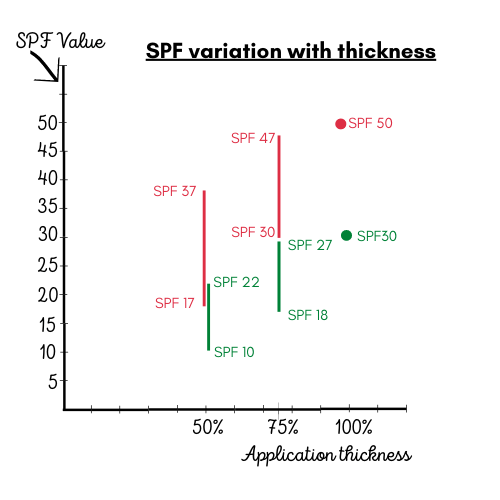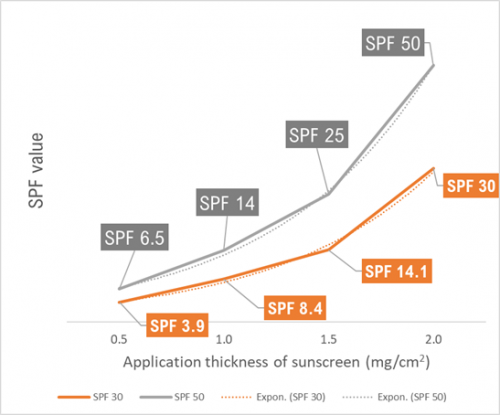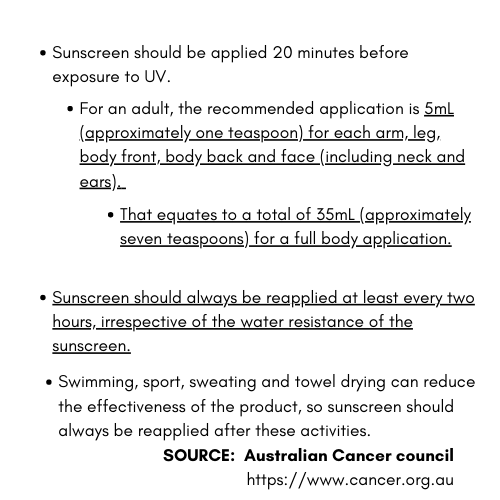In our age of disinformation I have noticed a trend where skincare influencers, including those with PhDs, appear to be saying that “applying half the recommended amount of sunscreen will result in about half the amount of protection.”
This suggests a linear relationship like this:

My view
(I am glad that I have had to revisit this area because its caused me what I suggest is the recommended amount of sunscreen application. I will from now on be suggesting what the American Cancer Council and not the Americans say on this top).
Going back to disinformation….I don’t need to get into the same shouting match as these other folks – No brand pays me to promote their product etc – BUT based on the scientific studies that are available to date, the suggestion that SPF 50 becomes SPF 25 when you reduce amount of applied sunscreen by 50% is plain wrong.
I’ll admit that these scientific studies leave a lot to be desired, but they clearly show a non-linear, (almost exponential decrease) in the SPF value. This is my view:

What does this graph show?
Applying half the recommended amount of sunscreen results in SPF 50 and SPF 30 becoming:
- SPF 30 becomes SPF 10-SPF 22 (at its worst, a 67% reduction in SPF)
- SPF 50 becomes SPF 17-SPF 37 (at its worst, a 66% reduction in SPF)
UVAPF becomes this:

GEEK ALERT: STOP READING IF YOU ARE NOT INTERESTED IN MY TECHNICAL REASONING
1 How is SPF measured?
The SPF you see on your label (labelled SPF) is determined using a more or less standard mechanism that involves application of 2mg/cm2
The SPF value ONLY holds if you apply the correct amount of sunscreen, which is bizarre because I haven’t met a single person who can eyeball 2 mg/cm2 correctly.
Therefore, it should come as no surprise that studies persistently show:
- People typically apply 0.5 to 1.2 mg/cm2 of sunscreen in real life instead of the 2 mg/cm2 dosage prescribed in SPF test.
- The cosmetic elegance of a sunscreen determines how much we apply. If a sunscreen is easier and less chalky and less gunky, people apply closer to the 2 mg/cm2 dose.
2 What is the relation between application thickness and SPF?
Study performed by Liu et al (20120
Honestly, there are a few studies (but not enough studies on this topic) and broadly these are the conclusions:
- At low SPFs, SPF 4 – SPF 15, the reduction in SPF best fits a linear curve
- At high SPFs, SPF 30 – SPF 55, the reduction in SPF best fits an exponential curve
Liu et al findings can be summarised as follows:

What this graph shows you is this:
- At 2mg/cm2 (the Recommended thickness or RT), actual SPF is equal to labelled SPF for SPF 50 and SPF 30
- At 1.5 mg/cm2 (75% of RT) the measured SPF is this:
- SPF 50 becomes SPF 25 (a 50% reduction)
- SPF 30 becomes SPF 14 (a more than 50% reduction
- At 1.0 mg/cm2 (so half the RT)
- SPF 50 becomes SPF 14 (a 72% reduction)
- SPF 30 becomes SPF 8.4 (a 72% reduction)
- At 0.5mg/cm2 (so 25% of the RT)
- SPF 50 becomes SPF 4 (a 92% reduction)
- SPF 30 becomes SPF 8.4 (a 86% reduction)
Other factors that Liu points to:
- Fitzpatrick skin types (I, II, III)
- All commercially available SPFs from SPF 4 to SPF 100
- Different application thicknesses
- Different combination of filters
Studies performed by Couteau et al
Coteau’s study is different from Liu’s as it was performed in the lab (and not on actual people). This is important because SPF is measured in vivo (on actual people). Secondly, Coteau is not a cosmetic scientist so her focus is really on design and measurement rather than an interpretation of the result (e.g., what further areas should we consider etc.) This is an important distinction to make, because it means that academic researchers being the elitist snobs that they are, ignore Coteau’s findings.
Coteau and her colleagues initially measured actual SPF and PF-UVA for 20 commercially available SPF products.
Their observations were this:
- Only 74% of the sunscreens they tested reached labelled SPF value
- For Zinc Oxide and Titanium Dioxide the use of these filters, does not permit SPF to go beyond SPF 30
They used a large amount of sunscreen, arguing that they’ve already demonstrated that an in vitro application of 15mg/cm2 to 25 cm2 of sun product correlates to the in vivo application of 2mg/cm2
Coteau’s results

They concluded that:
When 50% of the recommended thickness of sunscreen is applied:
- SPF 30 sunscreens range between SPF 10-SPF 23 applied
- SPF 50 sunscreens range between SPF 17-SPF 37
When 25% less sunscreen is applied:
- SPF 30 ranges between SPF 18-SPF 27
- SPF 50 ranges between SPF 30 – SPF 47
The same scientists performed subsequent tests for PF-UVA and concluded
– that on average, when PF=UVA is divided by a facort of 2.2. then the amount applies is reduced by ½
So this table becomes:

See also NOTE 1
(Note 1: When the dose applied is divided by 2, the reduction factor of SPF varies by 1.5 – 3.8 depending on the product. When the dose applied is divided by 4, the reduction factor of SPF varies between 2.5 – 13.5)
How much sunscreen should I be applying?
The American Cancer Org says you should apply:
- A nickel sized dollop to the face or 1/2 tsp tp 1/3 tsp to the face (including ears and neck)and
- about 1 oz (30ml) to the whole body.
This works out at slightly less than the recommended Australian amount of 1 teaspoon to the face and 35ml for the whole body, including 5ml for the face.
Australia has one of the highest rates of skin cancer globally, and this is the guidance of the Australian Cancer Council

SOURCES AND USES
Couteau C, Paparis E et al, Influence on SPF of the quantity of sunscreen product applied, International Journal of Pharmaceutics, Volume 437, Issues 1–2, 1 November 2012, Pages 250-252
Heerfordt IM. Sunscreen use at Danish beaches and how to improve coverage. Dan Med J. 2018;65(4):B5476.
Hedayat K, Ahmad Nasrollahi S, Firooz A. Quick and brief review: Comparison between different in vivo SPF determination methods. J Cosmet Dermatol. 2019;18(6):1617-1623. doi:10.1111/jocd.12941
Williams JD, Maitra P, Atillasoy E, Wu MM, Farberg AS, Rigel DS. SPF 100+ sunscreen is more protective against sunburn than SPF 50+ in actual use: Results of a randomized, double-blind, split-face, natural sunlight exposure clinical trial. J Am Acad Dermatol. 2018;78(5):902-910.e2. doi:10.1016/j.jaad.2017.12.062
Linden KG. Commentary: Sunscreen sun protection factor (SPF): Is higher better?. J Am Acad Dermatol. 2018;78(5):911-912. doi:10.1016/j.jaad.2018.02.056
Liu W, Wang X, Lai W, et al. Sunburn protection as a function of sunscreen application thickness differs between high and low SPFs. Photodermatol Photoimmunol Photomed. 2012;28(3):120-126. doi:10.1111/j.1600-0781.2012.00650.x
Teramura T, Mizuno M, Asano H, Naito N, Arakane K, Miyachi Y. Relationship between sun-protection factor and application thickness in high-performance sunscreen: double application of sunscreen is recommended. Clin Exp Dermatol. 2012;37(8):904-908. doi:10.1111/j.1365-2230.2012.04388.x
Schalka S, dos Reis VM, Cucé LC. The influence of the amount of sunscreen applied and its sun protection factor (SPF): evaluation of two sunscreens including the same ingredients at different concentrations. Photodermatol Photoimmunol Photomed. 2009;25(4):175-180. doi:10.1111/j.1600-0781.2009.00408.x
Kim SM, Oh BH, Lee YW, Choe YB, Ahn KJ. The relation between the amount of sunscreen applied and the sun protection factor in Asian skin. J Am Acad Dermatol. 2010;62(2):218-222. doi:10.1016/j.jaad.2009.06.047
Rohr M, Ernst N, Schrader A. Hybrid Diffuse Reflectance Spectroscopy: Non-Erythemal in vivo Testing of Sun Protection Factor. Skin Pharmacol Physiol. 2018;31(4):220-228. doi:10.1159/000488249
Bimczok R, Gers-Barlag H, Mundt C, et al. Influence of applied quantity of sunscreen products on the sun protection factor–a multicenter study organized by the DGK Task Force Sun Protection. Skin Pharmacol Physiol. 2007;20(1):57-64. doi:10.1159/000096173